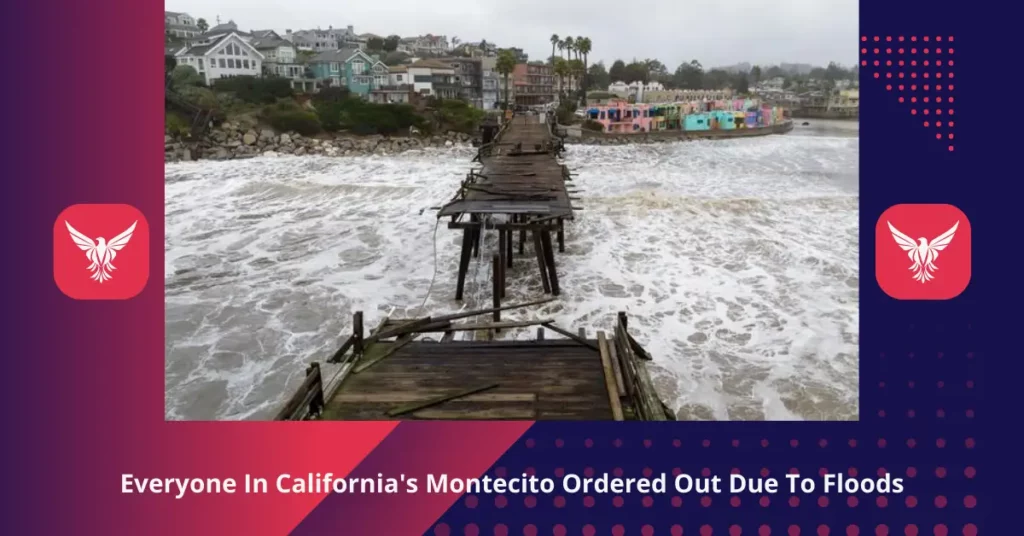Why Was Everyone In California’s Montecito Ordered Out Due To Floods? California’s SANTA CRUZ (AP) — As the latest in a string of solid storms battered the state Monday. Weary Californians battled flooding and mudslides while trees were toppled, and frustrated drivers encountered obstructions due to falling debris.
Why Are Thousands Of People Still Without Electricity?
On the fifth anniversary of the mudslide that claimed the lives of 23 people and destroyed more than 100 homes in the coastal enclave, the whole community of Montecito and its nearby canyons were ordered to evacuate.
Nearly 10,000 residents were ordered to leave their homes, according to Santa Barbara County Sheriff Bill Brown, who stated that the decision was made “based on the continued high rate of rainfall with no sign that that is going to alter before midnight.” He claimed that many roads were flooded and that creeks were overflowing.
Read More:
- Who Is Jillian Mele’s Husband? Why Did She Leave Fox News?
- What Is Craig Melvin Height? When Did He Join NBC News?
According to the National Weather Service, up to 8 inches (20 cm) of rain occurred within 12 hours, and several more inches are expected before the most recent storm system sweeps through. Celebrities like Oprah Winfrey and the Duke and Duchess of Sussex called upscale Montecito, which is crammed between mountains and the Pacific coast, home.
According to Melodye Serino, the deputy county administrative officer, Santa Cruz County, which is coastal and wooded, issued evacuation orders to around 32,000 inhabitants who live close to rivers and creeks swelled by rain. A video posted on social media showed a neighborhood underwater as muddy water surged up to a stop sign when the San Lorenzo River was reported to be at flood stage.
Highway 17, a vital but winding road into Santa Cruz from the San Francisco Bay Area, was shut in both directions by a sizable muddy slide. At the summit, traffic was diverted as cleanup personnel arrived.
Residents of tiny, flooded Felton maintained their composure and positive outlook despite the storms’ terrible nature, which claimed at least a dozen lives.
Customers without power in their houses received free coffee from Rocky’s Cafe owner Christine Patracuola on Monday. Due to obstructed highways, including a bridge over the San Lorenzo, her crew could not enter the building.
Nobody can be harmed by a bit of coffee, she added. You have to roll with the punches and hope you don’t get swept up in it; you can’t influence Mother Nature.
The third-generation owner of the Fern River Resort in Felton, Nicole Martin, claimed on Monday that her guests were “enjoying the show” as picnic tables and other trash floated down the swelling San Lorenzo as they sipped coffee and lounged on cabin porches under towering redwood trees.
According to Martin, the river generally lies approximately 60 feet (18 meters) below the cottages, but it has recently risen to a distance of 12 feet (4 meters). Martin insisted that she was unconcerned, although her family has owned the property for almost 60 years, and her grandfather examined the situation on Monday and dismissed it.
The resort got 8,000 pounds of sandbags, set up generators, and distributed lights to those who chose to stay in their cabins during the storm.
Several districts in Northern California closed their schools. According to the Sacramento Municipal Utility District, more than 35,000 customers in Sacramento still have no electricity, down from more than 350,000 a day earlier after gusts of 60 mph (97 kph) toppled towering trees into power wires.
The National Weather Service issued a warning about a “relentless parade of atmospheric rivers,” which are long moisture plumes that extend into the Pacific and have the potential to produce hefty rain and snowfall. Following storms last week that left people without power, flooded streets, and pounded the shoreline, precipitation is predicted over the next few days.
President Joe Biden declared an emergency on Monday to support storm response and relief efforts in more than a dozen counties, including Sacramento, Santa Cruz, and Los Angeles.
Governor Gavin Newsom reported that 12 individuals lost their lives due to severe weather over the previous ten days. He also urged residents to stay indoors and warned that this week’s storms could be much more hazardous.
The meteorological service issued a flood watch for much of Northern and Central California in response to the first of the newer, stronger storms, with 6 to 12 inches (15 to 30 centimeters) of rain forecast through Wednesday in the already saturated foothills of the Sacramento region.
In the foothill regions of the Los Angeles region, there was a chance of up to 8 inches (20 centimeters) of rain late on Monday and Tuesday. West-facing beaches might expect to see high waves as well.
The National Weather Service said that more than 10 inches (25 centimeters) of rain have fallen in San Francisco since December 26, while Mammoth Mountain, a well-known ski resort in the Eastern Sierra Nevada, has gotten nearly 10 feet (3 meters) of snow.
Although They Won’t Be Sufficient To End California’s Drought, The Storms Have Made A Difference:
After January 18, says University of California, Los Angeles climate scientist Daniel Swain, the rain should stop.
“That is my best judgment at the moment,” he said. “It’s good because it will give the rivers in Northern California, and now in Central California, an opportunity to come down.”
